Photo: A hybrid schedule at Belmont schools
It’s hybrid week at the Belmont Public Schools as the entire student population will be either returning to or begin for the first time hybrid in-person learning schedules.
In an email to the community from John Phelan, superintendent for Belmont schools, grades K-8 will resume their hybrid schedule on Monday, Dec. 7, while “we are happy to report Belmont High School students, grades 9 to 12 will start -person hybrid on Thursday, Dec. 10.”
The schedule for the Belmont High School hybrid schedule can be found here.
Phelan noted that principals from each of the six public schools will have sent out a communication to parents of children with more details on returning to the classroom.
“We appreciate the patience of our students, parents, faculty, and staff in pivoting to remote learning after the Thanksgiving holiday weekend,” said Phelan.
“We feel these proactive measures help keep the school community safe and give us a chance to assess and ‘reset’ the buildings for a healthy return to hybrid in-person learning,” he said.
Phelan said the district’s goal is to proactively and strategically pivot the instructional model for elementary, middle, and high schools when needed during the current pandemic environment while trying to limit disruptions to teaching and learning.




